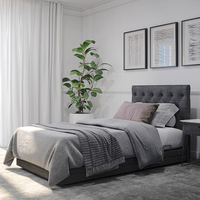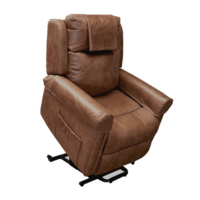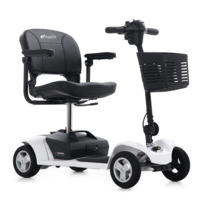How To Use A Slide Sheet
Safe manual handling in the home is an important part of daily life for the caregiver. We need to use the right equipment and techniques to provide safe and high-quality care.
Slide sheets are low friction devices when used correctly can minimise the risk of injury to the caregiver and the person you are moving.
In this blog, we will consider how to position slide sheets under a person in order to assist in moving them up the bed, across the bed, and rolling onto their side. We will also address how to remove the slide sheets from underneath someone.
Before you start:
- Position two slide sheets together and check for signs of damage or wear and tear.
- Check that they glide easily against each other.
- Ensure that the slide sheets are long enough so that they go from the person's head to their heels to avoid any skin shear or friction that may occur. If they do not reach their heels, a smaller slide sheet could be positioned under the heels.
- If you only have one slide sheet, ensure that it is the appropriate size when folded and the opening faces the direction of the movement.
- PLEASE NOTE: It is recommended to always use two slide sheets together.
The Log Rolling Method
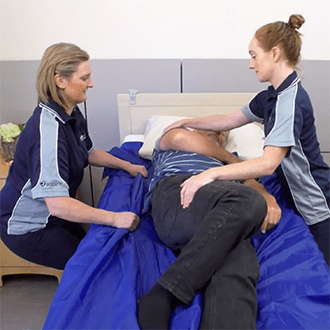
The rolling method is commonly used to position the slide sheets under a person.
You will need x2 slide sheets and x2 caregivers.
- Bring the bed to a safe working height for both caregivers so that they do not have to lean or bend over, putting themselves at risk of injury.
- If rolling the person to their right, bend their left knee, place their left arm across their chest, and ask them to turn their head to the right. Using safe manual handling techniques, roll them towards you. (Or vice versa when rolling to the person's left). The second caregiver can then insert the slide sheets from behind.
- Roll the person onto their back and ensure that the slide sheets are centrally positioned.
The Unravelling Method
Sometimes it can be difficult to roll a person due to their size, or because they may be in pain. If this is the case, the slide sheets can be positioned under them using the unravelling method.
- Place two slide sheets together lengthwise. Starting at the foot end, fold the sheets ~30cm at a time to the end. Ensuring that the opening ends are on the top, positioned under the person's pillow.
- The folded slide sheets should then be unravelled from the head towards the feet one-fold at a time. To do this, use the hand at the bed head end to hold the seams at the top edge and stabilise the slide sheet.
- Use the hand at the bed's foot end to move under the slide sheet and unravel each fold. Keep this hand in contact with the bed. Do not lift upwards as this will apply unnecessary pressure to the skin.
- If a person is on an alternating air mattress, set it temporarily to full inflation. This can help with the method.
Moving a person up the bed
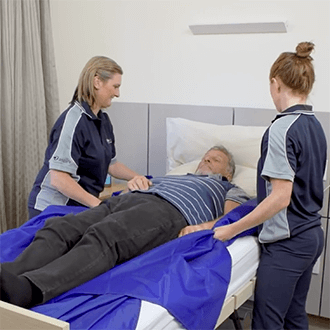
- When moving someone up the bed it is always a good idea to place a pillow at the headboard to prevent inadvertent injury.
- Both caregivers should hold the top slide sheet close to the person's body at the upper thigh and shoulder level. The caregiver's front foot should face the direction of movement towards the head end of the bed.
- Ensuring effective communication, the caregivers should then move the resident up the bed. Do this with a sliding movement. Do not be tempted to lift the slide sheet.
- If the person can participate in the movement, assist them as required to bend their knees and place their feet flat on the bed; fold the slide sheets so that they are not under their feet. If required, stabilize their knees and ankles to enable them to push themselves up the bed using their legs and feet.
- If the bed has the Trendelenburg function you can use it to reduce the manual handling effort required when moving a person up the bed. This bed function can also assist the person who is moving themself.
Side Positioning
Slide sheets can be used to position a person for side-lying
- Position the slide sheets using one of the methods already described.
- To ensure that there is enough space for positioning the person on their side safely, move the person using a lateral transfer to the side opposite the direction they will be facing.
- Always ensure that there is another caregiver on the opposite side of the bed to prevent an accidental fall.
- Use pillows or positioning aids as assessed and as required to maintain this new position.
Lateral transfers
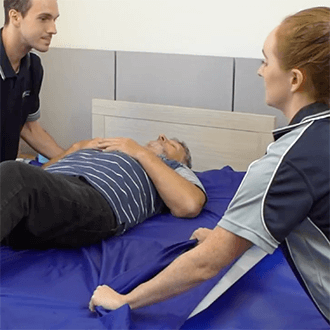
Slide sheets can also be used for lateral transfers. In a less common situation you may need to move someone from a bed to a shower trolley.
- Position the slide sheets as previously shown, and place a slide board under the slide sheets, bring the shower trolley into position and ensure that it is the same height or slightly lower than the bed.
- Ensure that the bed brakes and the shower trolley brakes are fully locked.
- The caregiver on the pull-side should hold the top slide sheet and transfer their weight from their front to their back leg, keeping their back straight and their legs, core muscles and body weight to carry out the transfer. While the caregiver on the push side should assist with the transfer.
Removing Slide Sheets
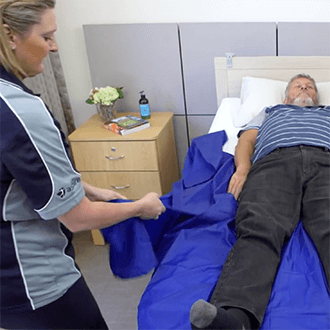
Slide sheets should never be left under a person.
- Remove the bottom sheet by taking its far top corner and bringing it back under itself whilst hand by hand moving down the bed.
- Do the same with the top slide sheet. By sliding the sheet under itself, you reduce shear forces that can cause skin damage or pressure injury.
- When removing the slide sheets after a roll has been carried out, remove them from behind the resident as there is more material at their back.
- If the person is at risk of sliding back down the bed as you remove the slide sheets, you can do this technique in reverse from the foot end to the headend direction i.e., start from the foot end and slide the sheet under itself towards the head end.
Remember these tips for safer manual handling when using slide sheets. For more information you can view full instruction video here.


















